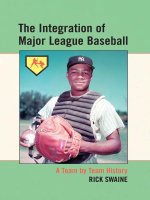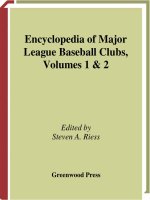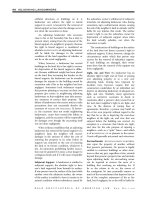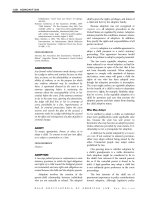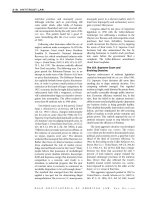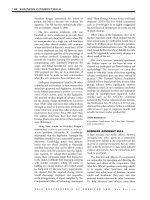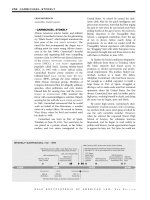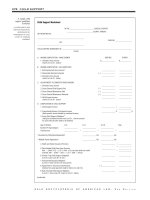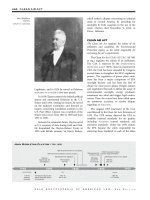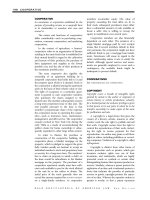ENCYCLOPEDIA OF Major League Baseball Clubs VOLUME I & II potx
Bạn đang xem bản rút gọn của tài liệu. Xem và tải ngay bản đầy đủ của tài liệu tại đây (9.26 MB, 1,103 trang )
Encyclopedia of Major
League Baseball Clubs,
Volumes 1 & 2
Edited by
Steven A. Riess
Greenwood Press
Encyclopedia of
Major League Baseball Clubs
ENCYCLOPEDIA OF
Major League
Baseball Clubs
VOLUME I
|
THE NATIONAL LEAGUE
Edited by Steven A. Riess
Greenwood Press
Westport, Connecticut • London
Library of Congress Cataloging-in-Publication Data
Encyclopedia of Major League Baseball clubs / edited by Steven A. Riess.
p. cm.
Includes bibliographical references and index.
ISBN 0–313–32991–5 (set : alk. paper) – ISBN 0–313–32992–3 (v. I : alk. paper).
– ISBN 0–313–32993–1 (v. II : alk. paper).
1. Baseball teams—United States—History—Encyclopedias. 2. Major League
Baseball (Organization)—History—Encyclopedias. I. Riess, Steven A.
GV875.A1E52 2006
796.357'640973—dc22 2006015368
British Library Cataloguing in Publication Data is available.
Copyright © 2006 by Steven A. Riess
All rights reserved. No portion of this book may be
reproduced, by any process or technique, without the
express written consent of the publisher.
Library of Congress Catalog Card Number: 2006015368
ISBN: 0–313–32991–5 (set)
0–313–32992–3 (vol. I)
0–313–32993–1 (vol. II)
First published in 2006
Greenwood Press, 88 Post Road West, Westport, CT 06881
An imprint of Greenwood Publishing Group, Inc.
www.greenwood.com
Printed in the United States of America
The paper used in this book complies with the
Permanent Paper Standard issued by the
National Information Standards Organization (Z39.48–1984).
10 9 8 7 6 5 4 3 2 1
Contents
Introduction: A Brief History of Major League Baseball Teams ix
Steven A. Riess
THE NATIONAL LEAGUE, VOLUME I
1. Arizona Diamondbacks 3
Laura A. Purcell and John H. Jordan
2. Atlanta Braves 13
David Stevens
3. Chicago Cubs 55
John E. Findling
4. Cincinnati Reds 99
Edward J. Rielly
5. Colorado Rockies 143
Thomas L. Altherr
6. Florida Marlins 153
Kevin B. Witherspoon
7. Houston Astros 163
Benjamin D. Lisle
8. Los Angeles Dodgers 181
Steven P. Gietschier
9. Milwaukee Brewers 225
John McCarthy and Christopher Miller
10. New York Mets 239
Maureen Smith
11. Philadelphia Phillies 257
John P. Rossi
12. Pittsburgh Pirates 299
Richard Peterson
13. San Diego Padres 339
Sarah Trembanis
14. San Francisco Giants 355
Andrew Goldblatt
15. St. Louis Cardinals 401
Jon David Cash
16. Washington Nationals 447
Michel Vigneault
THE AMERICAN LEAGUE, VOLUME II
17. Baltimore Orioles 465
William A. Borst
18. Boston Red Sox 499
Robert K. Barney and David E. Barney
19. Chicago White Sox 535
Richard C. Lindberg
20. Cleveland Indians 571
Philip C. Suchma
21. Detroit Tigers 605
Steven A. Riess
22. Kansas City Royals 639
Myles Schrag
23. Los Angeles Angels of Anaheim 655
Joel S. Franks
vi Contents
24. Minnesota Twins 671
Kristin M. Anderson and Christopher W. Kimball
25. New York Yankees 705
Steven A. Riess
26. Oakland Athletics 757
Robert F. Lewis II
27. Seattle Mariners 801
Adam R. Hornbuckle
28. Tampa Bay Devil Rays 815
Paul M. Pedersen
29. Texas Rangers 825
Jarrod Schenewark
30. Toronto Blue Jays 843
Russell Field
Appendix A: National League Season Standings, 1876–2005 861
Appendix B: American League Season Standings, 1901–2005 891
Appendix C: National League Team Total Attendance,
2005–1890 915
Appendix D: National League Team Daily Average Attendance,
2005–1890 923
Appendix E: National League Team Attendance Rankings,
2005–1890 931
Appendix F: American League Team Total Attendance,
2005–1901 939
Appendix G: American League Team Average Daily Attendance,
2005–1901 947
Appendix H: American League Team Attendance Rankings,
2005–1901 955
Appendix I: National League Team Consolidated Profi t and
Loss, 1920–56 (Dollars) 963
Appendix J: National League Team Dividends, 1920–56
(Dollars) 965
Appendix K: American League Team Consolidated Profi t and
Loss, 1920–56 (Dollars) 967
Contents vii
viii Contents
Appendix L: American League Team Dividends, 1920–56
(Dollars) 969
Appendix M: Major League Baseball Team Salaries, Selected
Years 971
Appendix N: Estimated MLB Revenues/Income, Franchise
Values (in Millions), and Salaries, 1990–2004 975
Appendix O: Major League Team Payrolls, 1987–1989,
2005–2006 999
Appendix P: Major League Ballparks, 2006 1005
Appendix Q: Major League Ballparks used by Current Teams,
with Name Changes 1009
Bibliography 1015
Index 1037
About the Editor and Contributors 1061
Introduction: A Brief History
of Major League Baseball Teams
Steven A. Riess
The cornerstone of Major League Baseball has been the leagues and their
teams. The majors are comprised of the National League, which dates back to
1876, and the American League, which became a major operation in 1901. The
NL was itself predated by the National Association of Professional Base Ball
Players (1871–75), which was arguably the fi rst major league. The NL itself op-
erated in conjunction with the American Association, a major league from 1882
to 1891, and was rivaled by the short-lived Union Association in 1884 and the
Players’ League in 1890. Since then the only other league to proclaim itself a
major league was the Federal League (1914–15), which at its death merged into
the established big leagues.
The major leagues currently have 30 members, some of which date back
over 125 years to the start of the NL, while Arizona and Tampa Bay just began
in 1998. The NL now consists of 16 teams; the AL consists of 14. They are part
of the most stable professional sports league in perhaps the entire world. No
franchise has gone out of business for over 100 years, and between 1903 and
1952, no franchise even moved from one city to another.
Baseball became the national pastime in the 1850s, and has long been the
preeminent team sport in North America. However, the fi rst team sports in
the United States and Canada were Native American contests like lacrosse
and shinny. The initial Euro-American team sport was cricket, brought to the
colonies by the English before the Revolutionary War. It became very popular
by the 1840s when a cricket fad emerged in the Northeast among English im-
migrants and middle-class Americans. By 1860 there were some 400 cricket
clubs and 10,000 players.
x Introduction
Cricket was quickly surpassed by the new game of baseball, which had sim-
pler rules, was easier to play
, had more dramatic shifts between offense and de-
fense, and required less time to complete. Baseball evolved from such English
games as rounders and old cat and surpassed in popularity other ball games,
most notably the Massachusetts Game, which had less offense and might take
an entire day to play. The rules of baseball were established by Alexander Joy
Cartwright of the New York Knickerbockers, a club of athletic white-collar
workers who played intraclub games at the Elysian Fields in Hoboken in 1845.
Their rules called for a diamond-shaped playing fi eld with bases at each corner,
90 feet apart. Three infi elders, except the “short” fi elder, stationed themselves
by a base. The pitcher, or “feeder,” threw underhand from 45 feet, with a run-
ning start. There were no balls or strikes, so hitters (“strikers”) waited until they
got a pitch they liked. Batters were put out by striking at the ball three times
without touching it, by being forced out at fi rst base, or by having their batted
ball caught on the fl y or on the fi rst bounce. Catchers positioned themselves
a few feet behind the striker to catch foul tips, which put the batter out. Run-
ners could be put out by being forced out or tagged with the ball when off a
base. Teams played an equal number of innings, with the fi rst team achieving
21 aces (runs) the winner. There was a single umpire, often dressed in a top
hat and tails. He sat at a table by third base, and rarely interfered with a game
unless there was a controversy. The Knickerbockers originally played intraclub
games, but in 1846 lost to the New York Club, 23–1. This was their only game
against an outside opponent until 1851. Very little is known about their oppo-
nent, although an item in the press a year before reported a ball game played
in Brooklyn between the New York Club and a Brooklyn squad.
In the mid-1850s the sport gained a lot of popularity, mainly in metropolitan
New York, where there were 10 clubs, 3 in New York and 7 in Brooklyn. In 1857
delegates from early New York–area clubs formed the fi rst baseball league, the
National Association of Base Ball Players (NABBP) to make up the rules (in-
cluding limiting games to nine innings), regulate competition, and maintain
the fraternal nature of the amateur sport. The game’s popularity was promoted
by journalists in the daily press and the sporting weeklies like the Spirit of the
Times and the Clipper, and by such events as the 1858 All-Star Game between
New York and Brooklyn players and the 1860 tours by the Brooklyn Excelsiors,
who played in upstate New York, Philadelphia, and Baltimore. One year later,
when the Civil War began, there were at least 200 junior and senior teams in
Greater New York. Their members and members of clubs in cities as far west as
Chicago and south as Baltimore became known as the ball-playing fraternity.
The clubs were social organizations mainly of young white-collar workers like
small shopkeepers, clerks, and college students, but were also organized by
residents of particular neighborhoods, workers in a particular craft (especially
butchers, fi remen, printers, and shipwrights), and African American organiza-
tions. Players were typically single men living in boardinghouses, looking for
a chance to socialize and display physical prowess. They used their participa-
Introduction xi
tion and the wearing of uniforms that designated them as ballplayers to gain
a sense of self-satisfaction and accomplishment that was missing from their
increasingly routinized labor
. In 1864 the game became manlier when the rules
required a fl y ball to be caught to register a putout.
The growing seriousness of play was refl ected by the establishment of a
championship system, which required the challenger to defeat the prior cham-
pion in a two-out-of-three series in the same year, involving riotous behavior
among spectators and the recruiting of players. In 1860 James Creighton was
engaged to pitch for the Brooklyn Excelsiors, a middle-class WASP squad, for
some compensation, making him the fi rst professional ballplayer. Their fi ercest
rivalry was with the Brooklyn Atlantics, comprised of working-class Irishmen.
They played each other for the championship in 1860. In the third and decid-
ing game, attended by over 15,000 spectators, several unpopular decisions by
the umpire led to a riot by the Atlantics’ Irish Catholic fans, and the game was
halted. The two teams never played again. In 1862, William Cammeyer built
an enclosure around his skating rink at a cost of $12,000. He made it available
for free to the Brooklyn Atlantics and began charging for admission. This was
a major step toward the commercialization and even greater competitiveness.
The Civil War hindered play in New York because so many young men went off
to war, but did help spread the game in military camps.
After the Civil War, several clubs, like the New York Mutuals and Brooklyn’s
Eckfords and Atlantics, employed various inducements, including government
sinecures, to recruit top men. By 1868, about 13 clubs were covertly profes-
sional even though that was barred by the NABBP. Then in 1869, the Cincinna-
ti Red Stockings became the fi rst overtly professional team, with players signed
to contracts that ranged from $600 to $1,400 a season. The team, which went
57–0–1, was fi nanced by subscriptions from 350 local businessmen led by at-
torney Aaron B. Champion, who sought to bolster the Queen City’s national
reputation. The Red Stockings’ success encouraged leaders in other midwest-
ern cities like Chicago to fi nance professional teams for the same reason. The
Chicago White Stockings were established in 1870 as a $20,000 corporation by
such boosters as hotelier Potter Palmer and Tribune publisher Joseph Medill.
THE NATIONAL ASSOCIATION
In 1871 10 professional teams that were either joint stock companies or
cooperatives organized by players themselves formed the National Associa-
tion of Professional Baseball Players (NA), the fi rst professional league. The
association was neither based on sound business principles nor controlled by
the players as its title suggested. The NA lasted fi ve years and went through 25
teams. Only the Red Stockings, Mutuals, and Philadelphia Athletics played all
fi ve years. In 1875, Boston won its fourth straight pennant with a record of 71–
8 and made a profi t of $3,261 from gross receipts of $38,000. Manager Harry
Wright did a great job recruiting players, promoting teamwork and scientifi c
xii Introduction
play on the fi
eld, and taking care of nearly all the business details. NA teams
had many problems, especially the unequal competition, which hurt fan inter-
est. Membership cost only $10, which enabled insuffi ciently fi nanced teams to
join the league. Players jumped from one team to another during the season
(revolving). Salaries averaged $1,300 to $1,600, which was too high to make
much profi t, and teams dropped out midyear if they were losing money. The
league was poorly administered, with no control of schedules. Furthermore,
there were rumors of fi xes.
THE NATIONAL LEAGUE
In 1876 the National League of Professional Base Ball Clubs was formed
to supplant the NA. The association was, as its name suggested, a business-
oriented venture. The main mover was Chicago businessman William Hulbert,
president of the White Stockings, who had previously signed up several star NA
players for the forthcoming season. The NL had franchises in Boston, Chicago,
Cincinnati, Hartford, Louisville, New York, Philadelphia, and St. Louis owned
by small merchants and politicians. The league required a minimum of 75,000
residents to keep out cities with insuffi cient population bases. Teams were giv-
en a territorial monopoly in their city. Visiting teams received 50 percent of the
50-cent base admission to offset hometown population disparities and promote
competition. The league banned Sunday games, liquor, and gambling to keep
out the riffraff and encourage middle-class audiences. Despite the best-laid
plans, the league struggled at fi rst. In 1876, only the champion Chicago squad
made money, and the Philadelphia Athletics and New York Mutuals were ex-
pelled for not completing their fi nal road trip. Then in 1877 four Louisville
Grays were discovered to have fi xed games and were banned for life. By 1880,
the NL had been through 16 teams. Some left because of fi nancial losses and
others were expelled for selling liquor and playing on Sundays.
The NL did not monopolize top-fl ight baseball in the late 1870s. There were
many strong independent clubs, who in 1877 established the loosely linked In-
ternational Association. In 1879 the NL fi lled its vacancies with Syracuse and
Troy, two of the stronger IA clubs, and in 1880 added Worcester, even though
those cities did not have 75,000 residents.
A key early problem for the teams was how to keep down salaries, which
comprised nearly two-thirds of their expenses. In 1879 management placed a
reserve clause into players’ contracts that bound them to their club in perpetu-
ity, although players could be sold, traded, or expelled for violating team rules.
The NL started with fi ve reserved men, but by 1883 it was reserving nearly all
its players, which caused salaries in the early 1880s to drop by 20 percent.
By 1882 the NL had gained enough success or the promise of a bright future
to encourage the establishment of a new rival league, the American Associa-
tion. Popularly known as the Beer and Whiskey League because of its owners’
prior businesses, the AA sought a working-class audience in the prosperous
Introduction xiii
1880s by selling beer, playing on Sunday, and charging just 25 cents for tickets.
The new league included teams from St. Louis and Cincinnati, which had both
been pushed out of the NL because of the drinking issue and Sunday baseball,
plus Pittsburgh, Philadelphia, Louisville, and Baltimore. These six cities had a
larger population base than the eight-team NL. After one season of bitter com-
petition, the rival leagues agreed to recognize each other
, honor the contracts
of reserved players, and establish exclusive territorial rights. They cooperated
in 1884 to repel the threat of a rival league, the Union Association. The NL and
AA teams played exhibition games after the regular season in 1883, and the
pennant winners played an exhibition series after the 1884 season titled “the
United States Championship.” One year later Chicago (NL) played St. Louis
(AA) for “the Championship of America.” In 1886 those teams played for “the
world’s championship,” with the winning St. Louis team taking all the gate re-
ceipts. The series was repeated through 1889.
Owners made good profi ts in the 1880s, when average attendance ranged
from 2,500 to 3,500. The valuable Chicago White Stockings reported very sub-
stantial earnings, and by 1887, had reportedly accumulated a surplus of about
$100,000. One year later, the team made $60,000. Even more lucrative were
the New York Giants, whose profi ts from 1885 through 1887 supposedly aver-
aged over $100,000. Teams tried to sustain their prosperity by creating a $2,500
maximum-salary classifi cation system in 1888, but it was not fully adhered to.
Owners also sought to control the social behavior of players on and off the
fi eld. Albert G. Spalding of the White Stockings fi ned dissipated players for di-
minishing their skills, and hired detectives to watch the most recalcitrant, like
Mike “King” Kelly, who along with his outfi eld mates were all traded because
of their drinking escapades.
THE PLAYERS’ LEAGUE
The players fought back in 1885 with the Brotherhood of Professional Base
Ball Players, professional sports’ fi rst union. Then, four years later, the union’s
leaders organized their own major league, the Players’ League, with the fi nan-
cial backing of politicians, streetcar magnates, and other businessmen who
were similar in background to owners of the AA and NL squads. Seven of the
eight teams were placed in NL cities. The PL dropped the reserve clause and
the blacklist, and appealed to middle-class fans by barring Sunday games and
beer sales; the basic admission was 50 cents. Any profi ts over $10,000 were to
be divided with the players.
The PL was a huge threat to the NL and AA, and received the support of
sporting weeklies. It put an excellent product on the fi eld, signing many major
leaguers, including most of the stars, and helped push up salaries for players
who did not jump to the league. The PL outdrew the NL, but only the Boston
Reds, with Mike “King” Kelly, made a profi t. All of the leagues lost heavily in
1890. The once profi table New York Giants nearly went bankrupt and Spald-
xiv Introduction
ing’s team suffered a $65,000 loss. The NL fought back vigorously, killing the
PL by co-opting the “contributors” or fi
nancial angels of the PL franchises, al-
lowing them to buy into NL teams.
THE CONSOLIDATED NATIONAL LEAGUE
The PL war did not lead to baseball peace. Confl ict over the reentry of cer-
tain players back to the Philadelphia AA team resulted in a new association
war with the NL that continued the upward spiral of salaries. The outcome
was the National Agreement of 1892, in which the AA closed down and four
of its teams joined the NL, now a 12-team league. The AA had had its ups and
downs, and 19 different teams had played in the league. Rosters were cut from
15 to 12 and salaries were cut 30–40 percent in 1892, and further sliced in
1893. A new unoffi cial $2,400 salary maximum was set and strictly enforced.
Team strength in the late nineteenth century was very unbalanced. The
White Stockings, with their roster of stars, dominated in the 1880s, winning
fi ve NL pennants (1880–82, 1885–86), while the St. Louis Browns won four
straight AA titles (1885–88) and fared well in postseason matches with the
NL. In the 1890s the most successful teams were the innovative Boston and
Baltimore clubs, which won 8 of 10 pennants, emphasizing “inside base-
ball.” The Baltimore Orioles were especially renowned for such tactics as
“the Baltimore chop,” daring baserunning, intimidation of opposing players,
unsportsmanlike play (tripping and blocking base runners), rowdy behavior,
and confronting umpires.
The unbalanced 12-team NL failed to maximize fan interest, and attendance
dropped to an average range of 2,000 to 3,000. Mediocre squads in the larg-
est cities, New York, Philadelphia, and Chicago, consistently fi nished out of
the money, while Louisville and St. Louis fi nished in last place for fi ve of eight
years. The sorriest situation was in Cleveland, whose Spiders went 20–134 in
1899. They drew under 200 fans at home, and spent the last two months on
the road as the “Exiles” or “Misfi ts.” The team’s poor showing was the result
of syndicate ownership whereby one magnate controlled two different teams.
Stanley Robison traded his best players to his brother’s St. Louis club, which
was a better draw. Syndicate ball also resulted in Louisville’s best players being
shunted to Pittsburgh, and Baltimore sending its stars to the Brooklyn Trol-
ley Dodgers, which helped them take the pennant in 1899 and 1900. In 1900
the NL dropped Cleveland, Baltimore, Louisville—all weakened by syndicate
ball—and Washington, returning to an eight-team league, further limiting the
number of jobs in the major leagues.
Teams then played at fl imsily constructed wooden ballparks that were fi re
hazards. In 1894 alone four burned down. Fields were in accessible locations
in safe neighborhoods, near good mass transit, where land costs were not too
high. Parks were almost never in the central business districts, but rather in
outlying middle-class neighborhoods. Teams were sensitive to rising rents and
Introduction xv
declining neighborhoods, and often moved. The White Stockings played at six
different sites between 1870 and 1894.
The NL teams lost money in 1892 but made money the next three years by
holding the salar
y line. In 1894, despite the Depression, eleven of twelve teams
were profi table, ranging from $5,000 to $40,000. However, business declined
in the late 1890s because of the long-term effects of the Depression, a lack of
competitiveness among the twelve teams, a weak franchise in New York, and
fan disgust at syndicate ball.
1
THE RISE OF THE AMERICAN LEAGUE
A new era in major-league baseball occurred with the emergence of the
American League as a major league in 1901. It was the vision of former journal-
ist and Western League president Byron Bancroft “Ban” Johnson, who saw that
professional baseball had a lot of profi t-making potential. Johnson reorganized
the old Western League into the American League in 1900, moving into loca-
tions that the NL had vacated (Cleveland, Baltimore, and Washington), and
shifting the St. Paul franchise, owned by Charles Comiskey, to his hometown
of Chicago. The new league was heavily funded by coal merchant Charles A.
Somers, who helped fi nance teams in Cleveland, Chicago, Philadelphia, and
Boston. In 1901 the AL tried to secure major-league status by raiding the senior
circuit, offering higher salaries that attracted at least 74 NL players to the new
league. This infusion of stars helped the AL surpass the NL in attendance in
1902. The fi nal part of the puzzle lay in securing a New York franchise, made
possible in 1903 because of the political clout of the local franchise’s owners.
The leagues came to an understanding in the National Agreement of 1903,
which ratifi ed the AL’s major-league status. The leagues recognized each other’s
reserve clauses, established a three-man National Commission to run orga-
nized baseball, and set up a minor-league draft system. The season ended with
a best-of-nine competition between each league’s champion, known as the
World Series.
Major-league teams then were owned by small businessmen and a number
of former baseball players, all of whom were politicians or closely connected
to professional politicians. They found the game a very profi table venture, with
growing audiences that rose from about 3,400 in 1901 to 6,133 by 1910. Teams
were proud of their fans like “Nuf Said” McGreevey and the Boston Royal
Rooters, or the Irish who sat at the Kerry Patch in St. Louis. As the noted Inde-
pendent pointed out in 1913: “The profi ts of baseball investment have proven
so dazzling in the last ten years that many prominent businessmen, politicians,
and capitalists have gone into the business with every promise of success.”
2
The Cleveland Indians, originally purchased for $10,000, were worth $100,000
by then, which was below the league average. The team made an average of
$55,000 a year from 1904 to 1912, while the Tigers made an $80,000 profi t from
1907 to 1911 and $48,000 a year from 1914 to 1918. The Cubs were probably
xvi Introduction
the most profi
table, making $1.2 million between 1906 and 1915. Furthermore,
each team president made a salary of about $25,000.
Owners presented themselves to their communities as public-spirited citi-
zens who supported baseball because of their interest in their hometowns, but
they were cold-blooded businessmen. They used their political connections
to secure inside information and preferential treatment from the municipality
to help them run their operation as effi ciently as possible. Their political con-
nections helped them secure Sunday baseball and police protection, minimize
license fees and undue municipal interference, hinder rivals like the Federal
League, and even suppress bad publicity and damaging evidence, as in the
Black Sox scandal.
The most important single problem owners faced after the rise of the AL was
the construction of modern ballparks that enabled them to increase seating
capacity, raise ticket prices, fulfi ll new building codes that stressed safety, and
cope with competition from other amusements like the glamorous new amuse-
ment parks and luxurious downtown vaudeville theaters. The owners no longer
moved from one wooden structure to another, but built expensive and perma-
nent fi re-resistant ballparks. The necessary technology, employing steel and
reinforced concrete, had previously been available, but owners did not want to
commit to expensive structures until the costs of construction had declined and
there was a suffi cient demand by fans. They relied on their political connec-
tions to get them inside information about the best potential sites, which they
either rented with very long-term leases or purchased outright. The fi rst fully
modern ballpark was Philadelphia’s 23,000-seat, $300,000 Shibe Park, built
in a French Renaissance style, and the $1 million (for land and construction)
Forbes Field in Pittsburgh, which seated 25,000 fans. By 1915 every major-
league city had a new modern ballpark, often with its own unique architec-
ture and interior dimensions, and the older grounds were remodeled with fi re-
resistant material.
Certain teams dominated the dead-ball era on the fi eld and at the box offi ce.
Between 1901 and 1910 the Pirates and Cubs each won four pennants. The Gi-
ants took two in that decade and four more in the 1910s. The Giants also domi-
nated at the box offi ce, drawing about 20 percent of NL attendance in the early
1900s, more than triple that of the lowly Boston Braves. The AL was more com-
petitive in the early 1900s, when no teams won more than the Tigers (three).
Then between 1910 and 1914 Connie Mack’s A’s won four pennants, and the
Red Sox, who had won twice in the early 1900s, won four between 1911 and
1918. Three teams won no pennants at all before 1920, including the Wash-
ington Senators, who only drew about seven percent of AL attendance. The
Chicago White Sox led with 17.6 percent, which refl ected the quality of its play,
Sunday ball, and the largest section of 25-cent seats in the major leagues.
Teams in the dead-ball era had a lot of individual identity, usually refl ecting
a dominant player like Ty Cobb of the Tigers or Walter Johnson of the Sena-
tors, but also powerful managers or owners like Connie Mack of the Athletics,
Introduction xvii
John McGraw of the Giants, and Charles Comiskey of the White Sox. Some
of the clubs’ identities refl
ected their play on the fi eld, such as “the Hitless
Wonders,” the world champion Sox of 1906, or Mack’s “$100,000 infi eld”
of the early 1910s, or the large number of college men on certain teams like
the Athletics and Giants. Teams either maintained traditional nicknames like
Dodgers or Giants or developed modern nicknames, usually refl ecting an as-
pect of the team’s identity, like the Boston Braves (named for a Tammany Hall
owner), the Chicago Cubs (for the team’s youth), or the Washington Senators
(for Capitol Hill).
TEAMS IN THE INTERWAR ERA
In the golden age of baseball during the 1920s, teams’ average annual profi t
margin was 18.3 percent on annual gross incomes exceeding $10 million. The
typical team drew 7,531 spectators per game, drawn by the new style of play
that emphasized power hitting over pitching. The majors had averaged from
1909 through 1918 a .254 batting average, 7.9 runs per game, and 198 home
runs per season. Then in 1920 the AL improved to a .283 batting average, 9.5
runs per game, and 370 home runs for the season. Much of the change was
due to Babe Ruth, who hit 54 home runs in 1920, more than any team in the
AL, and became an instant role model. The popularity of the slugging game
was supported by changes in pitching rules that banned many of the deceptive
pitches. Hence, from 1922 to 1941, the majors averaged a .280 batting average,
nearly 9.5 runs per game, and over 600 home runs per season.
The era was marked by the rise of the New York Yankees, whose owner,
Jacob Ruppert Jr., was willing to spend heavily to buy top players from Harry
Frazee of the Boston Red Sox. The Yankees won six pennants in the 1920s,
while their crosstown rivals, the Giants, won four (1921–24). A second dynasty
in the making was the St. Louis Cardinals (nine pennants between 1926 and
1946), and briefl y the Philadelphia Athletics, who won three straight champi-
onships (1929–31) with one of the greatest teams of all time, including four
Hall of Famers. Other strong teams in the 1930s included the Cubs, who won
four pennants from 1929 to 1938; the Giants, who won three; and the Cardi-
nals, who also won three.
The Yankees were the most profi table major league team in the 1920s, earn-
ing $3,272,214, and the most profi table NL team were the Pittsburgh Pirates, a
small market team who drew who made $2,308,148 and distributed $708,700
in dividends. They were a good draw and won the 1925 World Series and the
1927 pennant. However, over the long haul, the Cardinals were the most suc-
cessful small city in the majors because of Branch Rickey’s acumen in scouting
players, and creation of the lucrative farm system. Teams had previously owned
or had affi liations with minor-league clubs, who did most of the scouting and
recruiting of young ballplayers. In the 1920s, however, the high minor leagues
were outside the baseball draft, and held onto their prize players until they got
xviii Introduction
top dollar. Rickey decided to build a system of minor-league clubs to develop
talent. The Cardinals only controlled 5 clubs in 1929, but by 1936 controlled
28, and scouted the countr
y nationally looking for prospects. The Cardinals
brought up the best and sold the rest off. Their system became a model that
was soon widely emulated, especially by the Yankees, whose great dynasty
won four straight World Series (1936–39) and was stocked by several players
from their own farm system. According to baseball historian Benjamin Rader,
“The Yankees became the quintessential representatives of the big city, of ur-
ban America with its sophistication, cosmopolitanism, and ethnic and religious
heterogeneity, whereas the Cardinals were the quintessential representatives of
the small towns and the farms of rural American with its simplicity, rusticity,
and old stock Protestant homogeneity. Even the clean, understated elegance of
the pinstriped Yankee uniforms contrasted sharply with the images of the dust-
covered, baggy uniforms of the Cardinals’ Gas House Gang.”
3
When the Depression started, Major League Baseball was doing very well,
and in 1930 set a record profi t of $2,318,847. At a time when millions of people
were losing their jobs, entertainment was one of the last things they gave up so
they could have a momentary relief from the bad times. Owners struggled to
make ends meet during the depression, when attendance averaged only 6,578.
Major-league attendance dropped from 10.2 million in 1930 to 6.1 million by
1933. Gate receipts fell from $17 million in 1929 to $10.8 million in 1933. Aver-
age salaries declined to $4,500 from over $5,300 in 1929. The American League
began losing money in 1931, and the National League in 1932. The game did
not regain its profi tability until 1935. Low attendance, abetted by no Sunday
baseball, caused Connie Mack to sell off his stars. Management was slow to in-
novate and adjust to the conditions. The fi rst All-Star Game was held in 1933,
and two years later the Cincinnati Reds introduced night games to appeal to
working-class fans. By the end of the decade, all the parks but Wrigley Field
were equipped with artifi cial lighting, but each host team was limited to seven
night games. Teams also began to charge radio stations for broadcasting games,
which had started as a free service in the early 1920s. Teams were worried that
broadcasts hurt attendance, but in 1934, when the Cardinals halted them, at-
tendance still went down. New York’s three teams barred local radio broadcasts
from 1934 until 1939. By then the profi t potential of charging stations became
more apparent, and the New Yorkers lifted their ban, each securing $100,000
contracts for radio rights
BASEBALL DURING WORLD WAR II
During World War II, the major leagues struggled to survive, as millions of
baseball fans went overseas to serve their country, joined over time by hun-
dreds of major league ballplayers. Only 40 percent of starters in April 1941
were still starting three years later. Organized baseball was worried that the
government would curtail the national pastime, as it did in World War I, but
Introduction xix
President Franklin Roosevelt believed that would hurt morale and did not in-
terfere with the game. T
eams did cut costs by holding spring training near their
home. Attendance declined from a record 5,4 million in 1940 to 3.7 million in
1943, the fi rst season since 1934 that the major leagues did not make money.
Their teams had to rely on players who were too old, too young, or physically
unfi t for the draft. Performance levels declined to the point that in 1944, AL
batting champion George “Stuffy Stirnweiss hit only .309, and homer leader
Nick Ettan had just 22 homers. Cubs owner P.K. Wrigley was so concerned
about the state of baseball that he organized the All American Girls’ Profes-
sional Baseball League to sustain interest. Nonetheless, interest in the game
remained strong, and there were limited entertainment options on the home
front. Attendance revived in 1944 to a record 4.8 million and rose to nearly 5.6
million in 1945.
BASEBALL AFTER WORLD WAR II
Professional baseball was extremely popular after World War II. Profi ts in
1946 rose from $1.2 million the year before to nearly $4.9 million, and were
replicated the next season. Major-league attendance doubled to an average
of 16,027, and the minor leagues had their greatest boom ever, with 52 dif-
ferent leagues. With the business fl ourishing, the next great challenge after
the war was the integration of baseball. Virtually all owners opposed it for
fear of fomenting racial antagonisms among players and spectators, and be-
cause they did not want to lose revenue from renting their parks to local Negro
League clubs. The Brooklyn Dodgers alone challenged the status quo. Presi-
dent Branch Rickey had a long history of thinking outside the box. Rickey was
motivated by a desire to do the right thing and make a place for himself in
history, but he also wanted to build up the Dodgers’ roster with quality play-
ers available for little or no expenditure, and expected black players would
make the turnstiles click. Baseball’s Great Experiment did not go smoothly,
and several racist teams vigorously challenged Jackie Robinson in 1947, with
no success. Eleven weeks into the season Cleveland Indians’ maverick owner
Bill Veeck hired Larry Doby, the fi rst African American in the AL. However, the
pace of integration was very slow, and as late as 1953, only six teams had black
players, despite their domination of such NL honors as Rookie of the Year and
Most Valuable Player. The pace of integration was especially slow in the AL,
which in the 1950s often had less than half as many blacks as the New York
Giants alone. The last team to integrate was the Red Sox, who signed Pumpsie
Green in 1959.
A second great challenge was the relocation of franchises, beginning with
teams that were the least popular in two-team cities. This was connected to a
decline in the baseball business in 1950, when MLB made just $689,000 com-
pared to $3.3 million the year before. By 1952, ten of the sixteen teams were
losing money. Baseball was having a hard time competing with other leisure
xx Introduction
options, and was surpassed in attendance by horse racing. The game was los-
ing spectators to television, which at the same time, was a growing source of
income for teams in big media markets that sought to maximize profi ts.
The long-term stability of the major leagues ended in 1953 when the Boston
Braves, a struggling club that was the second-most-popular team in its city
,
moved to Milwaukee, abetted by local boosters who wanted to use baseball to
promote their city and build up the local economy. The move was supported
by the county government, which increased the capacity of County Stadium
and leased it to the Braves for a nominal sum. The venture was an enormous
short-term success at the box offi ce and on the fi eld, encouraging other teams
to copy the Braves, who led the major leagues in profi ts for three of the next
four years. In 1954 the hapless St. Louis Browns moved to Baltimore, where
they played at publicly owned Memorial Stadium, and in 1955 the cellar-
dwelling Philadelphia Athletics moved to Kansas City to play at Municipal Sta-
dium. Then in 1958 the Dodgers and Giants left New York City for the West
Coast. The Dodgers had failed to get New York City to support the team’s quest
for a larger, more accessible ballpark site, but Los Angeles was champing at the
bit. Walter O’Malley traded the local Wrigley Field for Chavez Ravine, the last
vacant sector in the vicinity of downtown. The county subsidized O’Malley by
providing him with 300 acres of free land worth nearly $6 million, $4.7 million
in new roads, a 99-year agreement on parking rights, and other concessions,
although he had to build his own stadium. Further north, the Giants moved
into San Francisco, where the city built Candlestick Park.
Three years later, MLB expanded for the fi rst time. The lords of baseball were
concerned about the protection of the antitrust exemption, especially after the
Washington Senators were permitted to move to Minneapolis in 1960, and
also the rise of a rival Continental League. The AL added two new teams in
1961 with a new Washington Senators and the Los Angeles Angels. One year
later the Mets were established to fi ll the void in New York City, along with the
Houston Colt .45s, the fi rst franchise in the rapidly growing state of Texas. The
new clubs had to pay a $1.8 million initiation fee and were staffed through a
draft of fringe major leaguers who cost $75,000 apiece. The new teams were
awful—the Mets went 40–122 in 1962—and for several years they were mired
in and around last place in a 10-team league.
Attendance growth in the 1960s was just fi ve percent over the 1950s, and
did not justify further expansion. However, lawsuits and pressure from Con-
gress following the Braves’ removal to Atlanta in 1965 and the Athletics’ move
to Oakland in 1967, the presence of cities seeking franchises, and interleague
power struggles resulted in adding Kansas City, Seattle, San Diego, and Mon-
treal in 1968. The AL charged the new owners $5.15 million to join, while the
NL doubled the fee to $10 million. In addition, each team paid $175,000 for
players selected from a pool. MLB created two 12-team leagues and a new di-
visional playoff format.
Introduction xxi
Television became a major factor in franchise profi tability
. TV revenues
were largely locally based and very uneven. Local TV revenues in 1950
amounted to $2.3 million for the 16 clubs, rising to $12.5 million in 1960
(in 1959 the Yankees were getting about $1 million from broadcast revenue,
compared to $150,000 for the Senators) and $20.7 million in 1969. In the
1950s national networks had agreements only with particular teams, mainly
in large-market cities, leaving teams in small cities without national televised
games. Starting in 1953 each team set up its own local broadcast policy.
League-wide packages were only permitted in 1961 following the passage of
the Sports Broadcasting Act.
Several multipurpose cookie-cutter municipal stadiums were built in the
period 1964–70, including downtown ballparks in Atlanta, St. Louis, Philadel-
phia, Pittsburgh, and Cincinnati. The latter four were constructed in declining
rust-belt cities near major highway interchanges to promote central business
districts and build confi dence in the future. The parks in the mid-1960s in At-
lanta, St. Louis, Anaheim, and San Diego cost $19–25 million, far less than the
$45 million Astrodome, the fi rst enclosed ballpark, completed in 1964. Costs
for open-air parks nearly doubled within a few years because of higher con-
struction expenses, to about $50 million for Cincinnati’s Riverfront Stadium,
Philadelphia’s Veterans Stadium, and Pittsburgh’s Three Rivers Stadium. In
1971, New York City took over Yankee Stadium and spent $106 million to
rebuild it. There was also a boom in publicly built suburban sports complexes
in sites like Bloomington, Minnesota, and Arlington, Texas, close to the homes
of baseball’s main fan base, as their communities also sought to promote eco-
nomic development.
The quality of teams in the postwar era was as unequal as ever. The Yankees
from 1947 to 1964 won every AL pennant except for three years, including fi ve
straight World Series between 1949 and 1953 and fi ve straight pennants from
1959 to 1964. This was probably the most signifi cant period of one-team domi-
nation in professional sports history. There was more balance in the NL, yet the
Dodgers dominated the period from 1946 to 1968 with 10 pennants, followed
by St. Louis with 4 and 3 each for the Giants and Braves. The Yankees’ success
was based on excellent scouting and a well-stocked farm system that produced
great players and prospects for trade bait. The Dodgers entered the postwar
era without a winning tradition, but made smart trades, spent money wisely,
brought in black players, and had very stable managerial leadership. A team
originally built on power for Ebbets Field retooled in Los Angeles for a larger
ballpark with a team that stressed pitching and speed.
TEAMS IN THE MULTIDIVISIONAL ERA
The last teams to relocate were expansion clubs: the Seattle Pilots, who
moved to Milwaukee in 1970 and became the Brewers, and the Washington
xxii Introduction
Senators, who moved to Arlington in 1972 and became the Texas Rangers. The
AL expanded in 1976 with new teams in Seattle and T
oronto, but there was no
more expansion until 1993, when the NL added teams in Denver and Miami.
In 1998 the AL added a team in Tampa Bay and the NL added one in Phoenix.
That year Milwaukee moved from the AL to the NL, the fi rst league switch since
the American Association went out of business in 1891. The leagues divided
themselves into three divisions in 1994, setting up a four-team playoff format
with a wild card. Then, in 1997, interleague play was initiated to increase fan
interest.
There was more parity in the 1970s and 1980s, in part because the new for-
mat enabled more opportunities to win at least a divisional title, and the long
playoffs made it easier for favorites to stumble. In the 1980s, only fi ve teams
did not win a pennant. City size was less important than in previous eras. In
the NL St. Louis and Cincinnati won as many as New York, Los Angeles, and
Chicago combined, while in the AL, Oakland and Baltimore also won more
than those three cities. Teams could less readily stockpile talent compared to
the past because of 40-man roster limits and the introduction of the amateur
free-agent draft in 1965, with teams selecting in reverse order of fi nish.
However, parity went out the door in the 1990s with the return of dynasties.
The Indians and Yankees each won fi ve straight divisional titles (1995–99),
with the Yankees winning four of fi ve World Series. The Braves’ domination of
the NL was even greater, winning their division every year from 1991 through
2005, including one string of eight straight appearance in the NL Champion-
ship Series.
The end of the reserve system provided a great opportunity for the cash-rich
Yankees, who cornered the best free agents to win four times between 1976 and
1981, but then failed to return to the World Series until the mid-1990s. Free
agency severely hurt other clubs, and led to the breakup of Cincinnati’s Big Red
Machine and the Oakland A’s. Rader argues that small cities were able to win
if they had excellent players, stable rosters, and unwavering strong leadership.
Baltimore’s success was tied to having the same manager, Earl Weaver, for 18
years. Yet managerial stability was not necessarily a hallmark of strong teams,
since the Athletics had 12 managers in this era.
In the late 1990s free-agency era there was a heavy correlation between
salaries and success. Baltimore was the only one of the four highest-paid teams
in 1995–99 not to make every playoff. The gap between rich and poor widened.
In 1995 the top seven teams spent 2.6 times as much as the seven cheapest
teams, but in 1999 the margin had increased to 3.9:1. The Yankees were the
most generous, paying players $88.1 million in 1999, compared to $15.1 mil-
lion for the Florida Marlins. Teams with the lowest average payrolls rarely or
never made playoffs, and did not win a single playoff game between 1995 and
1999. The poorest teams won only about 40 percent of their games.
Rader found that there were different routes for success. Certain teams em-
phasized building a core from within the organization through the amateur draft
Introduction xxiii
rather than trying for quick results through free agency. Some teams believed
in drafting experienced collegians rather than high-school seniors, while others
began to invest heavily in less expensive Latin players. The Dodgers heavily
emphasized stability throughout their organization. W
alt Alston managed for
23 years, and upon retirement was replaced by Tommy Lasorda, who spent 47
years with the organization. The Dodgers built a specially constructed village in
Vero Beach for spring training, where they brought in their old heroes to instill a
team tradition, and tried to sign players to long-term contacts rather than recruit
free agents. On the other hand, teams in turmoil also won, like the individual-
istic Athletics of the 1970s with their unkempt hair and mustaches, although
they were united in their hatred of owner Charles Finley. And of course there
was the constant turmoil that beset the Yankees under George Steinbrenner
and his revolving corps of managers—19 from 1969 through 1991.
Owners were fabulously wealthy men or corporate executives who treated
their teams as hobbies for self-gratifi cation and self-advertisement. The only
owners in the 1990s who did not have independent wealth were the O’Malleys
and Griffi ths, scions of baseball families. The new owners were not baseball
experts, but meddlers like Gene Autry, Ray Kroc, George Steinbrenner, Charles
Finley, and Ted Turner, who enjoyed seeing their names in the papers. Owners
used the team to make money, not necessarily by winning pennants, but by
using tax advantages like depreciation of players and creating synergy, like the
Chicago Tribune and its purchase of the Chicago Cubs, who appear on its TV
station WGN; Ted Turner’s cable network, which was heavily reliant on Braves
ball games; and Disney, which purchased the Angels from Autry.
In the 1990s, a new style of ballpark emerged with the 1992 construction of
Camden Yards in Baltimore, the fi rst retro park. These parks are smaller in ca-
pacity (averaging about 45,000 seats). They combine the intimacy of the early
modern ballparks with the ambience of Disney World, plus upscale dining and
the comforts of expensive luxury suites that cater to corporate America. Only 8
of 30 ballparks in use today are privately owned.
Until recently the names of ballparks were readily identifi able because they
were named for the team (Yankee Stadium), owner (Comiskey Park), or loca-
tion (Three Rivers Stadium in Pittsburgh), or for an important contributor to the
sport (Shea Stadium, in honor of the man who brought the National League
back to New York). A few parks maintain this tradition, like Oriole Park at
Camden Yards, and Turner Field in Atlanta. However, a new trend emerged
with recent ballpark constructions, as the structures are now being named for
businesses, usually with a local base, that are spending millions of dollars to
secure the naming rights to advertise themselves. The average deal is for about
$75 million over 25 years. Local corporations who have purchased naming
rights include Petco in San Diego and Comerica in Detroit. Their manage-
ment believes this investment enhances their visibility and displays hometown
boosterism. This support is particularly keen among fi nancial institutions like
Citizens’ Bank in Philadelphia, Chase in Arizona, Great American Insurance
xxiv Introduction
Company in Cincinnati, and PNC Bank in Pittsburgh, as well as beer compa-
nies like Milwaukee’
s Miller Park, Denver’s Coors Field, and St. Louis’s Busch
Stadium. Some name changes are often coming very swiftly, as in the case
with the San Francisco ballpark that opened in 2000 as Pacifi c Bell Park, be-
came SBC Park, and now is AT&T Park because of corporate mergers. Another
reason for change has been the naming company’s fi nancial distress, notably
Enron, whose name no longer graces Houston’s major league ballpark.
Team profi tability varied substantially based on several factors, including
attendance, ticket prices, and media revenue, as well as concessions and park-
ing. Overall teams averaged about 21,367 spectators a game in 1980, which ap-
preciated signifi cantly to 26,115 in 1990. The rise was due to the quality of the
product, which was comprised of the team on the fi eld and the ballpark (which
includes accessibility, nature of the neighborhood, park ambience, ticket pric-
es, and condition of the facility). When the Blue Jays moved into SkyDome in
1989, they set major-league attendance records for three straight years. The
Orioles at the new Camden Yards in the late 1990s averaged 45,034 in their
fi rst fi ve years, a 50 percent increase over their past four years at the old Me-
morial Stadium. Attendance still varies a lot among different teams. In 1989,
for instance, the Chicago White Sox and Atlanta Braves were outdrawn by
the minor-league Buffalo Bisons. In 2001, 7 teams drew over 3 million, led by
Seattle with 3.7 million, while 10 drew under 2 million, with a low of 642,000
for Montreal.
Teams have widely different pricing strategies, which heavily impinges on
profi ts; this was not the case in the past, when average prices were uniform.
Ticket pricing refl ects supply and demand and the introduction of skyboxes.
Average ticket prices rose from $8.64 in 1991 to $14.91 in 1999. The aver-
age ticket in 2001 cost $19.70, ranging from tiny Fenway Park, where the Red
Sox charged $36.08, down to $9.55 for Minnesota. Boston’s cheapest bleacher
tickets cost more than a fi eld box seat at Dodger Stadium. The Dodgers outdrew
the Red Sox by 400,000 fans, but earned $39 million less at the box offi ce.
Ticket-price differentials have helped shape the social composition of audi-
ences, which along with crowd behavior varies from team to team. Kansas
City is well known for drawing a regional audience, while about 30 percent
of Baltimore’s crowds are from out of town. The Chicago White Sox tradition-
ally drew white ethnic and black working-class fans from the South Side, its
geographic home base. For several years these fans had a reputation for being
pretty rowdy. However, more recently, its audiences are increasingly middle-
class suburbanites. The Cubs always drew most of their fans from the North
Side; for the last 30 years, it has drawn a fun-loving yuppie audience who
come for the ambience and sunshine of Wrigley Field and the nightlife of the
gentrifi ed neighborhood more than for the Cubs. Similarly, the Dodgers’ fans
are considered the most easygoing, coming late and leaving early. On the other
hand, the Phillies were known for having a mean-spirited crowd. Fan loyalty,
